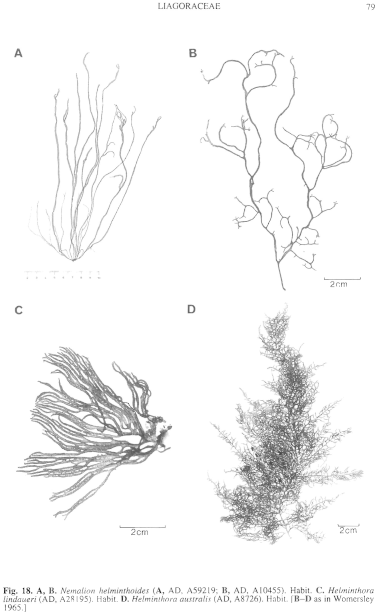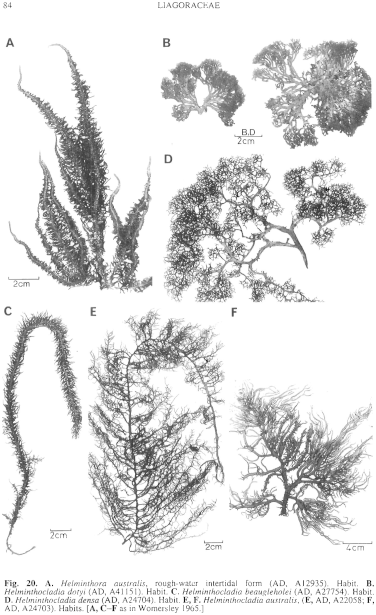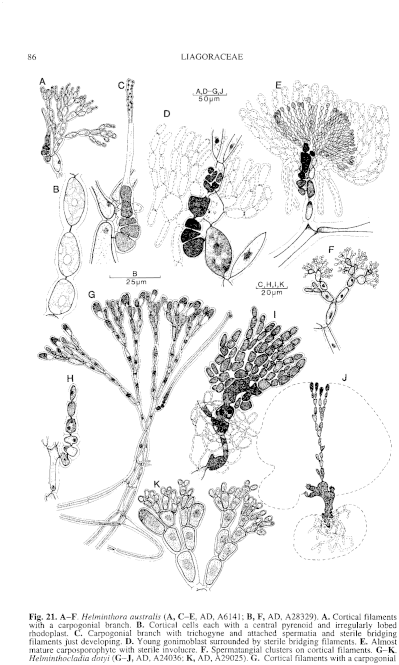|
|
|
|
|
|||||||||||
|
Electronic Flora of South Australia Species Fact Sheet
Phylum Rhodophyta – Class Florideophyceae – Order Nemaliales – Family Liagoraceae
Selected citations: Womersley 1965: 461, figs 17–22, pl. 2 fig. 2, pl. 3 fig. 1.
Synonym
H. divaricata J. Agardh sensu Harvey 1855a: 552; 1863, synop.: xxxviii. Lucas 1909: 21.
Thallus (gametophyte) (Figs 18D, 20A) red-brown, 3–20 (–25) cm high, with irregular branching of several orders, varying from slender, open, and sparse in calm water forms (forma epiphytica of Levring, on Posidonia) to profusely and fairly densely branched, more robust forms of broadly conical outline (Fig. 18D) in medium water movement (on Posidonia or on rock) and to densely branched, robust, more narrowly pyramidal forms (Fig. 20A) on rock on rough-water coasts (forma pyramidalis of Levring). Axes 1–2 mm in diameter below, branches mostly 0.5–0.8 mm in diameter. Holdfast discoid, 1–5 (–8) mm across; epiphytic or epilithic. Structure multiaxial, with a medulla 0.5–0.8 mm broad in larger branches, forming a compact strand of long, broad cells [(10–) 20–40 µm in diameter], and a mature cortex (160–) 200–400 µm broad, formed of tufts of anticlinal, straight or slightly curved filaments (Fig. 21A) of ovoid cells mostly 8–12 µm in diameter, L/D 1.5–2.5, filaments dichotomously branched at each cell near their base, with the outer part unbranched and terminating in progressively smaller cells; slender rhizoidal filaments arise from the basal cell of cortical tufts, growing over the medulla; rhodoplasts (Fig. 21B) irregularly stellate to lobed, each with a central pyrenoid; hairs usually present near apices of branches.
Tetrasporophyte unknown.
Reproduction: Sexual thalli dioecious or occasionally monoecious. Carpogonial branches (Fig. 21A, C) 4-celled, curved, laterally situated usually on the second cell from the base of a cortical branch below a dichotomy, with the carpogonium dumb-bell shaped. Zygote dividing transversely, the upper cell initiating the gonimoblast (Fig. 21D), carpogonial branch cells and especially the lower zygote cell becoming densely protoplasmic; gonimoblast compact (Fig. 21E), situated below the surface of the cortex, 150–200 (–240) µm across in surface view, with terminal ovoid carposporangia mostly 10–18 µm long by 6–8 µm in diameter. Fusion cell not formed, and only occasionally do the pit-connections of the carpogonial branch enlarge (Fig. 21E). Sterile post-fertilization filaments arise from the cells of the dichotomy above the supporting cell (Fig. 21C) and develop around the carpogonial branch as bridging filaments; from these, erect filaments develop (Fig. 21D) to form a prominent involucre (of slenderer filaments than those of the cortex) around the carposporophyte, overarching it when mature (Fig. 21E); descending rhizoidal filaments penetrate towards the medulla, forming an indistinct and usually not strongly developed mass, 50–200 (–320) µm long. Spermatangial clusters (Fig. 21F) transformed from terminal 1–3 cells of cortical filaments, radially paniculate or sometimes digitate when young; spermatangial initials elongate, producing 1–3 sub-spherical spermatangia 2–3 µm in diameter.
Type from Western Port, Vic. (J.B. Wilson); holotype in Herb. Agardh, LD, 31986.
Selected specimens: Cottesloe, W. Aust., on Amphibolis antarctica, upper sublittoral (Gordon, 14.xi.1968; AD, A34073). Head of the Great Australian Bight, S. Aust., drift (Woelkerling, 4.xi.1968; AD, A34201). Kellidie Bay, Coffin Bay, S. Aust., lower eulittoral (Womersley, 22.viii.1967; AD, A31824 -"Marine Algae of southern Australia" No. 70a). Wanna, S. Aust., lower eulittoral (Womersley, 21.viii.1967; AD, A31809 -"Marine Algae of southern Australia" No. 70b). Hardwicke Bay, Yorke Pen., S. Aust., low eulittoral pools (Womersley, 9.xi.1980; AD, A51842). Aldinga, S. Aust., drift (Gordon, 12.x.1964; AD, A28329). American R. inlet, Kangaroo I., S. Aust., sublittoral on Posidonia australis (Womersley, 2.xi.1947; AD, A6141). Vivonne Bay, Kangaroo I., S. Aust., mid eulittoral (Womersley, 4.i.1950; AD, Al2935). Pennington Bay, Kangaroo I., S. Aust., rear eulittoral (Womersley, 29.viii.1948; AD, A8726). Walkerville, Vic., low eulittoral pool (Sinkora A2207, 18.x.1975; AD, A48475). Bombay Rock, Tamar Est., Tas., upper sublittoral (Womersley, 27.i.1949; AD, A10363).
Distribution: New Zealand.
Cottesloe, W. Aust., to Walkerville, Vic., the north coast of Tasmania, and Kangaroo Point, Derwent R., Tasmania. (MEL 8591).
Taxonomic notes: Helminthora australis varies considerably in habit (see above) depending on degree of water movement, but structurally and reproductively the forms are identical.
References:
HARVEY, W.H. (1855a). Some account of the marine botany of the colony of Western Australia. Trans. R. Ir. Acad. 22, 525–566.
HARVEY, W.H. (1863). Phycologia Australica. Vol. 5, Plates 241–300, synop., pp. i-lxxiii. (Reeve: London.)
LEVRING, T. (1953). The marine algae of Australia. I. Rhodophyta: Goniotrichales, Bangiales and Némalionales. Arkiv för Bot. Ser. 2, 2, 457–530.
LUCAS, A.H.S. (1909). Revised list of the Fucoideae and Florideae of Australia. Proc. Linn. Soc. N.S.W. 34, 9–60.
WOMERSLEY, H.B.S. (1965). The Helminthocladiaceae (Rhodophyta) of southern Australia. Aust. J. Bot. 13, 451–487, Plates 1–7.
The Marine Benthic Flora of Southern Australia Part IIIA complete list of references.
Publication:
Womersley, H.B.S. (14 January, 1994)
The Marine Benthic Flora of Southern Australia
Rhodophyta. Part IIIA, Bangiophyceae and Florideophyceae (to Gigartinales)
Reproduced with permission from The Marine Benthic Flora of Southern Australia Part IIIA 1994, by H.B.S. Womersley. Australian Biological Resources Study, Canberra. Copyright Commonwealth of Australia.
Illustrations in Womersley Part IIIA, 1994: FIGS 18D, 20A, 21A–F.

Figure 18 enlarge
Fig. 18. A, B. Nemalion helminthoides (A, AD, A59219; B, AD, A10455). Habit. C. Helminthora lindaueri (AD, A28195). Habit. D. Helminthora australis (AD, A8726). Habit. [B–D as in Womersley 1965.]

Figure 20 enlarge
Fig. 20. A. Helminthora australis, rough-water intertidal form (AD, Al2935). Habit. B. Helminthocladia dotyi (AD, A41151). Habit. C. Helminthocladia beaugleholei (AD, A27754). Habit. D. Helminthocladia densa (AD, A24704). Habit. E, F. Helminthocladia australis, (E, AD, A22058; F, AD, A24703). Habits. [A, C–F as in Womersley 1965.]

Figure 21 enlarge
Fig. 21. A–F. Helminthora australis (A, C–E, AD, A6141; B, F, AD, A28329). A. Cortical filaments with a carpogonial branch. B. Cortical cells each with a central pyrenoid and irregularly lobed rhodoplast. C. Carpogonial branch with trichogyne and attached spermatia and sterile bridging filaments just developing. D. Young gonimoblast surrounded by sterile bridging filaments. E. Almost mature carposporophyte with sterile involucre. F. Spermatangial clusters on cortical filaments. G–K. Helminthocladia dotyi (G–J, AD, A24036; K, AD, A29025). G. Cortical filaments with a carpogonial branch. H. Abnormal cortical filament originating from an unfertilized carpogonial branch. I. Semi-mature gonimoblast with basal fusion cell and irregular mass of sterile filaments. J. Outline of mature carposporophyte with fusion cell and basal mass of sterile filaments. K. Spermatangial clusters (in median view). [A, C–K after Womersley 1965.]

|
Email Contact: State Herbarium of South Australia |

|